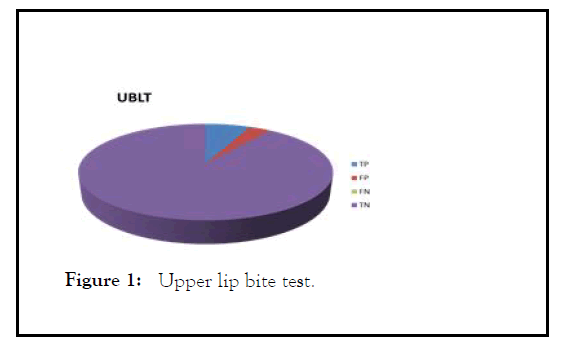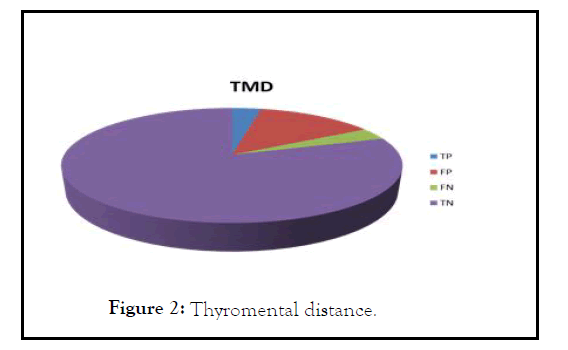
Anesthesia & Clinical Research
Open Access
ISSN: 2155-6148

ISSN: 2155-6148
Research Article - (2022)Volume 13, Issue 11
Aim: To compare upper lip bite test with the measurement of thyromental distance for the prediction of difficult intubation.
Objectives: To compare sensitivity, specificity, positive predictive value and negative predictive value of Upper Lip Bite Test (ULBT) with the measurement of Thyro-Mental Distance (TMD) for the prediction of difficult intubation.
Background: The Upper Lip Bite Test (ULBT) introduced in 2003 is a simple method for predicting difficult intubations. According to this test, the higher a patient can bite the upper lip with the lower incisors, the lower the risk of difficult intubation. Given the necessity for evaluation and re-evaluation of a newer predictive method, this study was conducted to compare the ULBT with another method for difficult airway prediction, the measurement of Thyromental Distance (TMD).
Upper lips bite test; Thyromental distance; Difficult intubation; Difficult airway
Difficult laryngoscopy and difficult tracheal intubation occur in 1.5% to 13% patients undergoing general anesthesia and has always been a concern for anesthesiologist’s.
ULBT (Upper Lip Bite Test) is a representation of the temporomandibular joint movement. Multiple factors such as weight, head and neck mobility, jaw movement, receding mandible and buck teeth are included in the ULBT, it would be expected to offer a higher predictive value for assessment of a difficult airway in patients having jaw subluxation combined with buck teeth.
In ULBT three classes: class I, patient is able to raise the lower incisors above the vermilion line; class II, upper lip below the vermilion line; and class III, unable to bite the upper lip.
Another method for difficult airway prediction is measurement of the Thyromental Distance (TMD). The distance between the laryngeal prominence of the thyroid cartilage and the mental protuberance of the mandible was measured. A TMD less than or equal to 6 cm was considered to be predictive of difficult intubation.
The current study was carried out in the form of a prospective, observational, single-blind evaluation, with the objective of determining the sensitivity, specificity, and positive and negative predictive values of the ULBT compared with TMD for predicting difficult intubations.
Thirty patients who were posted for elective intubation were assessed both via upper lip bite test and thyromental distance and difficulty of intubation was predicted in pre-operative evaluation period and post induction of anesthesia the laryngoscope view was recorded via Cormack Lehane classification .
Inclusion criteria
• Patient willing to sign the written and informed consent.
• Patients of either gender aged between 18 and 60 years.
• Patients belonging to American Society of anesthesiologists grade I and II
• Patients scheduled for elective surgery under general anaesthesia requiring endotracheal intubation.
Exclusion criteria
• Patient’s refusal from taking part in the study.
• Patients with previous history of burn or trauma to airway.
• Patients having tumors or mass in the laryngeal, facial and cervical region.
• Patients with restricted mobility of the neck and mandible.
In this prospective, observational, study, non-blinded study 30 patients who required inhaled general anesthesia with endotracheal intubation for elective surgery were enrolled for evaluation of the accuracy in predicting difficult intubation by TMD measurement and ULBT. In the ULBT, the capacity of biting the upper lip is categorized into three classes: class I, a patient is able to raise the lower incisors above the vermilion line; class II, a patient is able to bite the upper lip below the vermilion line; and class III, a patient is unable to bite the upper lip. The TMD of the subjects was measured in the upright sitting position with the head in complete extension. The distance between the laryngeal prominence of the thyroid cartilage and the mental protuberance of the mandible was measured with a ruler.
A TMD less than or equal to 4 cm was considered to be predictive of difficult intubation. After induction of anesthesia with a standard protocol, the patient's grade of laryngeal view by the Cormack-Lehane classification was documented by an anesthesiologist with at least 3 years' experience who was unaware of prior evaluations. A TMD equal to or less than 4 cm and a class III ULBT were considered to be predictive of difficult intubation. A Cormack-Lehane class III or IV was considered a difficult intubation.
Statistical analysis and results
Data will be analyzed by SPSS (Statistical Package for Social Scientist) 15.0. The characteristics and demographic data of each group are presented descriptively in terms of percentage, mean, and standard deviation. Categorical data was analyzed by chi-square test or Fisher’s exact test. Ordinal data will be analyzed by chi-square test or by the Kolmogorov- Smirnovtest. The significance value used was α-5% with 80% power.
Of 30 patients involved in the study two had difficult intubation. Sensitivity, specificity, positive and negative predictive values and accuracy were 100%, 94.44%, 66.67%, 100% and 95% for ULBT, and 50%, 77.78%, 20%, 93.33% and 75% for TMD (Table 1 and Figure 1). Sensitivity, Specificity, positive predictive value and accuracy were found to be significantly higher for the ULBT than for TMD (p<0.05) (Table 2 and Figure 2). Analysis of thyromental distance and upper lip bite test shows in Table 3.
| Upper lip bite test | Difficult intubation | Easy intubation |
|---|---|---|
| Predicated difficult | 2 | 1 |
| Predicted easy | 0 | 27 |
Table 1: Upper lip bite test.

Figure 1: Upper lip bite test.
| Thyromental distance | Difficult intubation | Easy intubation |
|---|---|---|
| Predicted difficult | 1 | 4 |
| Predicted easy | 1 | 24 |
Table 2: Thyromental distance.

Figure 2: Thyromental distance.
| Analysis | ULBT | TMD |
|---|---|---|
| Sensitivity | 100% | 50% |
| Specificity | 94.44% | 77.78% |
| Positive predictive value | 66.67% | 20% |
| Negative predicted value | 100% | 93.33% |
| Accuracy | 95% | 75% |
Table 3: Analysis of thyromental distance and upper lip bite test.
Early detection of difficult airway is important because failed intubation can have serious consequences which lead to high morbidity and mortality of the patient [2,3]. The ability to predict a difficult tracheal intubation permits anaesthesiologists to take precautions to decrease the risk [4].
In 2003, Khan et al introduced a simple method for predicting difficult intubations known as the Upper Lip Bite Test (ULBT). ULBT is a representation of the temporomandibular joint movement. Multiple factors such as weight, head and neck mobility, jaw movement, receding mandible and buck teeth are included in the ULBT, it would be expected to offer a higher predictive value for assessment of a difficult airway in patients having jaw subluxation combined with buck teeth [5].
The TMD of the subjects was measured in the upright sitting position with the head in complete extension. The distance between the laryngeal prominence of the thyroid cartilage and the mental protuberance of the mandible was measured. A TMD less than or equal to 6 cm was considered to be predictive of difficult intubation [6].
In this study it was noted that upper lip bite test had a better sensitivity, specificity, positive predicitive value and negative predicitive value compared to thyromental distance in the prediction of difficult intubation and efficiently predicited and prevented morbidity and mortality that could have happened without accurate prediction of difficult intubation [7].
This study was consistent with study done in 2018 by Elnaz Faramarzi which concluded that Upper lip bite test has moderate sensitivity and positive predictive value and high specificity and accuracy and can be used as useful bedside test for evaluation of patient airway in patients requiring general anaesthesia.
Considering that the ULBT is a simple objective evaluation that is not dependant on particular circumstances or specific instruments, it is of utmost importance to evaluate and reevaluate it in various conditions and make comparisons with alter-native tests.
As for the issue of questionable reliability of the TMD, it may not appear to be an appropriate test, but both tests were contrasted with the gold standard, and not directly compared with each other. The current study provided further information for the database of literature regarding both methods.
The limitation in our study is that the study was conducted in a short period of time with a small sample size. Conducting the study for a longer duration of time and with a larger sample size would yield better results. Other parameters detecting difficult airway was not assessed. This study was concerned only with elective surgical patients, and emergency patients were neglected. This study is non-blinded hence some observer bias is present [8].
ULBT is a useful bedside test for evaluation of patient airway before the general anesthesia with greater sensitivity, specificity, positive predictive value, negative predictive value and accuracy than TMD.
The authors are thankful to the patients and technical staff without whom this publication would not be possible.
Source of funding: Nil
Conflict of interest: None declared
[Cross Ref] [Google Scholar] [Pub Med]
[Cross Ref] [Google Scholar] [Pub Med]
[Cross Ref] [Google Scholar] [Pub Med]
[Cross Ref] [Google Scholar] [Pub Med]
[Cross Ref] [Google Scholar] [Pub Med]
[Cross Ref] [Google Scholar] [Pub Med]
[Cross Ref] [Google Scholar] [Pub Med]
Citation: Niranjni S, Harish Kumar J, Girimurugan, Lakshmi (2022) An Observational Study for the Comparison of Upper Lip Bite Test with the Measurement of Thyromental Distance for the Prediction of Difficult Intubation. J Anesth Clin Res. 13:033
Received: 18-Feb-2022, Manuscript No. JACR-22-14577; Editor assigned: 21-Feb-2022, Pre QC No. JACR-22-14577 (PQ); Reviewed: 07-Mar-2022, QC No. JACR-22-14577; Revised: 25-Nov-2022, Manuscript No. JACR-22-14577 (R); Accepted: 26-Nov-2022 Published: 02-Dec-2022 , DOI: 10.35248/2155-6148.22.13.100033
Copyright: © 2022 Niranjni S, et al. This is an open-access article distributed under the terms of the Creative Commons Attribution License, which permits unrestricted use, distribution, and reproduction in any medium, provided the original author and source are credited.